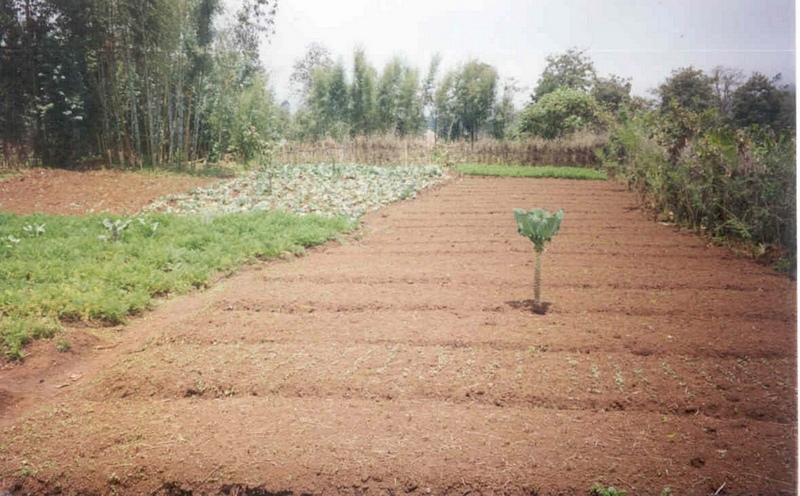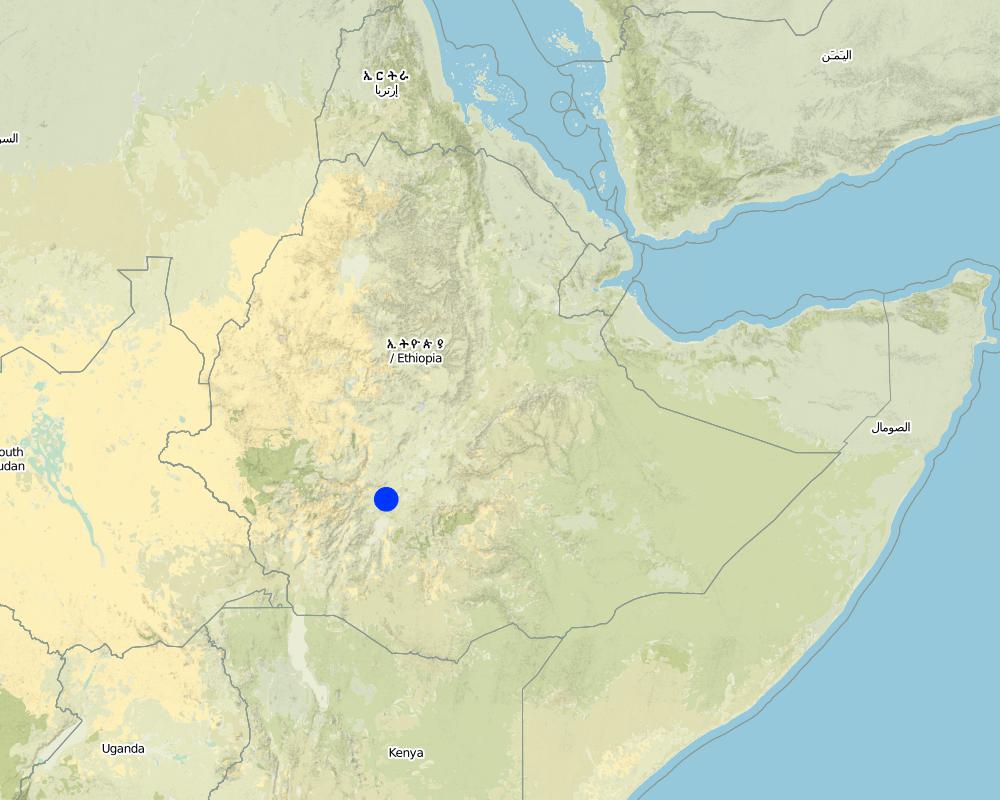Homestead Development [埃塞俄比亚]
- 创建:
- 更新:
- 编制者: Unknown User
- 编辑者: –
- 审查者: Fabian Ottiger, Alexandra Gavilano
technologies_993 - 埃塞俄比亚
查看章节
全部展开 全部收起1. 一般信息
1.2 参与该技术评估和文件编制的资源人员和机构的联系方式
关键资源人
SLM专业人员:
Bernahu Kidist
Gamo Gofa Zone Rural Development Department
埃塞俄比亚
有助于对技术进行记录/评估的机构名称(如相关)
Gamo Gofa Zone Rural Development Department - 埃塞俄比亚1.3 关于使用通过WOCAT记录的数据的条件
编制者和关键资源人员接受有关使用通过WOCAT记录数据的条件。:
是
2. SLM技术的说明
2.1 技术简介
技术定义:
It is an integrated land husbandary practice aimed at improving farm productivity of a household through the sustainable land resources development
2.2 技术的详细说明
说明:
t involves the practicing of various farming practices in order to increase the productivity of land and improve the livelihoods.
Purpose of the Technology: it is a technology which can improve farm productivity interms of biomass, food, farmers income and prevent the area from land degradation.
Establishment / maintenance activities and inputs: Constructing of the required SWC measures and undertake vegetative panting
Natural / human environment: increase biomass, productivity increase per unit area, improve soil fertility, reduce soil erosion, improve soil moisture content.
2.3 技术照片
2.5 已应用该技术的、本评估所涵盖的国家/地区/地点
国家:
埃塞俄比亚
区域/州/省:
Southern Nation & Nationalitie Peoples Region (SNNPR)
有关地点的进一步说明:
Boreda Woreda
注释:
Total area covered by the SLM Technology is 3 km2.
the technology area is increasing from time to time due to its economical benefits has brought the farming community
Map
×2.6 实施日期
如果不知道确切的年份,请说明大概的日期:
- 不到10年前(最近)
2.7 技术介绍
详细说明该技术是如何引入的:
- 通过项目/外部干预
注释(项目类型等):
Developed in the country
3. SLM技术的分类
3.1 该技术的主要目的
- 改良生产
3.2 应用该技术的当前土地利用类型
同一土地单元内混合使用的土地::
是
具体说明混合土地使用(作物/放牧/树木):
- 林牧业

农田
- 一年一作
- 多年一作(非木材)
- 乔木与灌木的种植
年作 - 具体指明作物:
- 谷类 - 大麦
- 谷物类 - 玉米
- 豆科牧草和豆类 - 豆子
- 根/块茎作物 - 红薯、山药、芋头/椰子,其他
- wheat
- enset, Desho, elephant grass
乔木和灌木种植 - 指定作物:
- 咖啡,露天种植
- 仁果类(苹果、梨子、柑橘等)
每年的生长季节数:
- 2
具体说明:
Longest growing period in days: 185 Longest growing period from month to month: Jun - Dec Second longest growing period in days: 150 Second longest growing period from month to month: Jan - May
采用间作制度了吗?:
是
如果是,说明哪些作物是间作的:
maize and beans

牧场
- free grazing, stall feeding
注释:
Major land use problems (compiler’s opinion): loss of topsoil, reduction of soil fertility, population and livestock pressure, free grazing
Major land use problems (land users’ perception): shortage of farm land and grazing land, low productivity of land
Type of cropping system and major crops comments: wheat-bean-sweet potato-maize-barely-beans
3.4 供水
该技术所应用土地的供水:
- 雨养
3.5 该技术所属的SLM组
- 家庭花园
3.6 包含该技术的可持续土地管理措施
3.7 该技术强调的主要土地退化类型

土壤水蚀
- Wt:表土流失/地表侵蚀
- Wg:冲沟侵蚀/沟蚀

化学性土壤退化
- Cn:肥力下降和有机质含量下降(非侵蚀所致)
注释:
Main type of degradation addressed: Wt: loss of topsoil / surface erosion
Secondary types of degradation addressed: Wg: gully erosion / gullying, Cn: fertility decline and reduced organic matter content
3.8 防止、减少或恢复土地退化
具体数量名该技术与土地退化有关的目标:
- 减少土地退化
- 修复/恢复严重退化的土地
注释:
Main goals: mitigation / reduction of land degradation
Secondary goals: rehabilitation / reclamation of denuded land
4. 技术规范、实施活动、投入和成本
4.1 该技术的技术图纸
技术规范(与技术图纸相关):
Technical knowledge required for field staff / advisors: high
Technical knowledge required for land users: moderate
Main technical functions: increase in soil fertility
Secondary technical functions: improvement of ground cover, increase in organic matter, improve feed and fodder source, change feeding habit
Mixed cropping / intercropping
Material/ species: maize and beans
Remarks: 50,000/60,000
Contour planting / strip cropping
Material/ species: maize, with legumes/sweet potato
Remarks: 5-10 meters of strip width
Green manure
Material/ species: lupin and vetch
Manure / compost / residues
Material/ species: leaves/manure/ash
Aligned: -contour
Vegetative material: G : grass
Vertical interval between rows / strips / blocks (m): 1-2m
Grass species: Desho, elephant grass
Slope (which determines the spacing indicated above): 12.00%
Bund/ bank: level
Vertical interval between structures (m): 1.3 m
Spacing between structures (m): 15
Depth of ditches/pits/dams (m): 0.5
Width of ditches/pits/dams (m): 0.6
Length of ditches/pits/dams (m): 50
Height of bunds/banks/others (m): 0.6
Width of bunds/banks/others (m): 0.5
Length of bunds/banks/others (m): 50
Bund/ bank: graded
Vertical interval between structures (m): 1.2 m
Spacing between structures (m): 14
Depth of ditches/pits/dams (m): 0.6
Width of ditches/pits/dams (m): 0.7
Length of ditches/pits/dams (m): 45
Height of bunds/banks/others (m): 0.65
Width of bunds/banks/others (m): 0.5
Length of bunds/banks/others (m): 45 m
Construction material (earth): excavate from the channel and fill between stone walls
Construction material (stone): stone is collected from the field
Construction material (wood): wood is used for the construction of check dams
Slope (which determines the spacing indicated above): 7%
If the original slope has changed as a result of the Technology, the slope today is: 5%
Lateral gradient along the structure: 0%
Vegetation is used for stabilisation of structures.
4.2 有关投入和成本计算的一般信息
其它/国家货币(具体说明):
Birr
如相关,注明美元与当地货币的汇率(例如1美元=79.9巴西雷亚尔):1美元=:
8.0
注明雇用劳工的每日平均工资成本:
0.70
4.3 技术建立活动
| 活动 | 时间(季度) | |
|---|---|---|
| 1. | seedling raising | on set of rain |
| 2. | transplanting grass | during rainy season |
| 3. | weed and cultivation | during rainy season |
| 4. | surveying | dry season |
| 5. | Digging channel | dry season |
| 6. | bund construction | dry season |
| 7. | bund stablization with grasses | rain season |
4.4 技术建立所需要的费用和投入
| 对投入进行具体说明 | 单位 | 数量 | 单位成本 | 每项投入的总成本 | 土地使用者承担的成本% | |
|---|---|---|---|---|---|---|
| 劳动力 | Labour | ha | 1.0 | 220.0 | 220.0 | 48.0 |
| 设备 | Tools | ha | 1.0 | 45.0 | 45.0 | 50.0 |
| 植物材料 | Seeds | ha | 1.0 | 9.0 | 9.0 | |
| 肥料和杀菌剂 | Compost/manure | ha | 1.0 | 68.0 | 68.0 | 100.0 |
| 施工材料 | Stone | ha | 1.0 | 4.0 | 4.0 | |
| 施工材料 | Sand | ha | 1.0 | 1.5 | 1.5 | |
| 施工材料 | Cement | ha | 1.0 | 3.0 | 3.0 | |
| 其它 | Others | ha | 1.0 | 64.0 | 64.0 | |
| 技术建立所需总成本 | 414.5 | |||||
| 技术建立总成本,美元 | 51.81 | |||||
注释:
Duration of establishment phase: 12 month(s)
4.5 维护/经常性活动
| 活动 | 时间/频率 | |
|---|---|---|
| 1. | tillage | dry season / twice |
| 2. | planting | on set of rainfall / once |
| 3. | compost application | during planting / twice |
| 4. | weeding | rainy season / twice |
| 5. | harvest | end of season / once |
| 6. | replanting of grass | mid of the rainy season /once |
| 7. | cleaning the channel | before rains/annual |
| 8. | maintenance of the broken part of the bund | before & after rains/twice a year |
4.6 维护/经常性活动所需要的费用和投入(每年)
| 对投入进行具体说明 | 单位 | 数量 | 单位成本 | 每项投入的总成本 | 土地使用者承担的成本% | |
|---|---|---|---|---|---|---|
| 劳动力 | Labour | ha | 1.0 | 31.0 | 31.0 | 100.0 |
| 技术维护所需总成本 | 31.0 | |||||
| 技术维护总成本,美元 | 3.88 | |||||
注释:
Machinery/ tools: hoe, shovel, sickle, axe,
Some of the costs such as seedling planting, transportation and digging of pit is not included. A person can dig 75 pits/day and he can plant 50 seedlings/day
4.7 影响成本的最重要因素
描述影响成本的最决定性因素:
Market flactuation for industrial product, labour cost, uneven distribution of rainfall
5. 自然和人文环境
5.1 气候
年降雨量
- < 250毫米
- 251-500毫米
- 501-750毫米
- 751-1,000毫米
- 1,001-1,500毫米
- 1,501-2,000毫米
- 2,001-3,000毫米
- 3,001-4,000毫米
- > 4,000毫米
农业气候带
- 半湿润
LGP is 185 days
5.2 地形
平均坡度:
- 水平(0-2%)
- 缓降(3-5%)
- 平缓(6-10%)
- 滚坡(11-15%)
- 崎岖(16-30%)
- 陡峭(31-60%)
- 非常陡峭(>60%)
地形:
- 高原/平原
- 山脊
- 山坡
- 山地斜坡
- 麓坡
- 谷底
垂直分布带:
- 0-100 m a.s.l.
- 101-500 m a.s.l.
- 501-1,000 m a.s.l.
- 1,001-1,500 m a.s.l.
- 1,501-2,000 m a.s.l.
- 2,001-2,500 m a.s.l.
- 2,501-3,000 m a.s.l.
- 3,001-4,000 m a.s.l.
- > 4,000 m a.s.l.
5.3 土壤
平均土层深度:
- 非常浅(0-20厘米)
- 浅(21-50厘米)
- 中等深度(51-80厘米)
- 深(81-120厘米)
- 非常深(> 120厘米)
土壤质地(表土):
- 中粒(壤土、粉土)
- 细粒/重质(粘土)
表土有机质:
- 低(<1%)
如有可能,附上完整的土壤描述或具体说明可用的信息,例如土壤类型、土壤酸碱度、阳离子交换能力、氮、盐度等。:
Soil fertility is low
Soil drainage/infiltration is good
Soil water storage capacity is medium-high
5.6 应用该技术的土地使用者的特征
生产系统的市场定位:
- 生计(自给)
- 混合(生计/商业)
非农收入:
- 低于全部收入的10%
相对财富水平:
- 贫瘠
- 平均水平
机械化水平:
- 手工作业
- 畜力牵引
说明土地使用者的其他有关特征:
Population density: 100-200 persons/km2
Annual population growth: 2% - 3%
55% of the land users are average wealthy and own 70% of the land.
45% of the land users are poor and own 30% of the land.
Off-farm income specification: land user who work on SWC activities have more income because of the incentive they obtain for participation.
Level of mechanization is manual work (hoe) and animal traction (oxen)
5.7 应用该技术的土地使用者使用的平均土地面积
- < 0.5 公顷
- 0.5-1 公顷
- 1-2 公顷
- 2-5公顷
- 5-15公顷
- 15-50公顷
- 50-100公顷
- 100-500公顷
- 500-1,000公顷
- 1,000-10,000公顷
- > 10,000公顷
5.8 土地所有权、土地使用权和水使用权
土地所有权:
- 州
土地使用权:
- 个人
6. 影响和结论性说明
6.1 该技术的现场影响
社会经济效应
生产
作物生产
注释/具体说明:
during good time
饲料生产
饲料质量
木材生产
生产区域
土地管理
收入和成本
农业收入
注释/具体说明:
during good time
经济差异
工作量
其它社会经济效应
Input constraints
社会文化影响
SLM/土地退化知识
生态影响
水循环/径流
地表径流
SLM之前的数量:
60
SLM之后的数量:
28
土壤
土壤水分
注释/具体说明:
Can lead to waterlogging
土壤覆盖层
土壤流失
SLM之前的数量:
43
SLM之后的数量:
2
减少气候和灾害风险
风速
其它生态影响
Biodiversity
Soil fertility
6.2 该技术的场外影响已经显现
旱季稳定可靠的水流
下游洪水
下游淤积
地下水/河流污染
6.4 成本效益分析
技术收益与技术建立成本相比如何(从土地使用者的角度看)?
短期回报:
稍微积极
长期回报:
积极
技术收益与技术维护成本/经常性成本相比如何(从土地使用者的角度看)?
短期回报:
积极
长期回报:
非常积极
6.5 技术采用
如若可行,进行量化(住户数量和/或覆盖面积):
2534
在所有采用这项技术的人当中,有多少人是自发的,即未获得任何物质奖励/付款?:
- 91-100%
注释:
100% of land user families have adopted the Technology with external material support
362 land user families have adopted the Technology with external material support
Comments on acceptance with external material support: survey results
100% of land user families have adopted the Technology without any external material support
2172 land user families have adopted the Technology without any external material support
Comments on spontaneous adoption: survey results
There is a moderate trend towards spontaneous adoption of the Technology
Comments on adoption trend: the technology has immediate return
6.7 该技术的优点/长处/机会
| 土地使用者眼中的长处/优势/机会 |
|---|
|
improved soil fertility How can they be sustained / enhanced? practicing more of fertility enhancing techniques that use locally available material |
|
soil erosion is controlled How can they be sustained / enhanced? biological and physical SWC activities increased and maintained |
|
increased household income How can they be sustained / enhanced? biological and physical SWC activities increased and maintained |
|
availability of animal feed How can they be sustained / enhanced? planting grass and fodder plants |
| 编制者或其他关键资源人员认为的长处/优势/机会 |
|---|
|
it is a practice serving as model showing on how to integrate different options of technologies How can they be sustained / enhanced? focusing on techniques which enhance production |
|
it is implemented on individual household basis How can they be sustained / enhanced? through developing self-help activities |
| interest has been developed on funding agencies |
6.8 技术的弱点/缺点/风险及其克服方法
| 土地使用者认为的弱点/缺点/风险 | 如何克服它们? |
|---|---|
| labour consuming | group formation and participation of all members of the family |
| physical structures occupied more land | increase the productivity of land per unit area and use vegetative measures |
| high input demand | maximum use of locally available inputs |
| 编制者或其他关键资源人员认为的弱点/缺点/风险 | 如何克服它们? |
|---|---|
| labour and time consuming | participate all family members |
| incentive dependant | give incentives only for the needy |
链接和模块
全部展开 全部收起链接
无链接
模块
无模块




